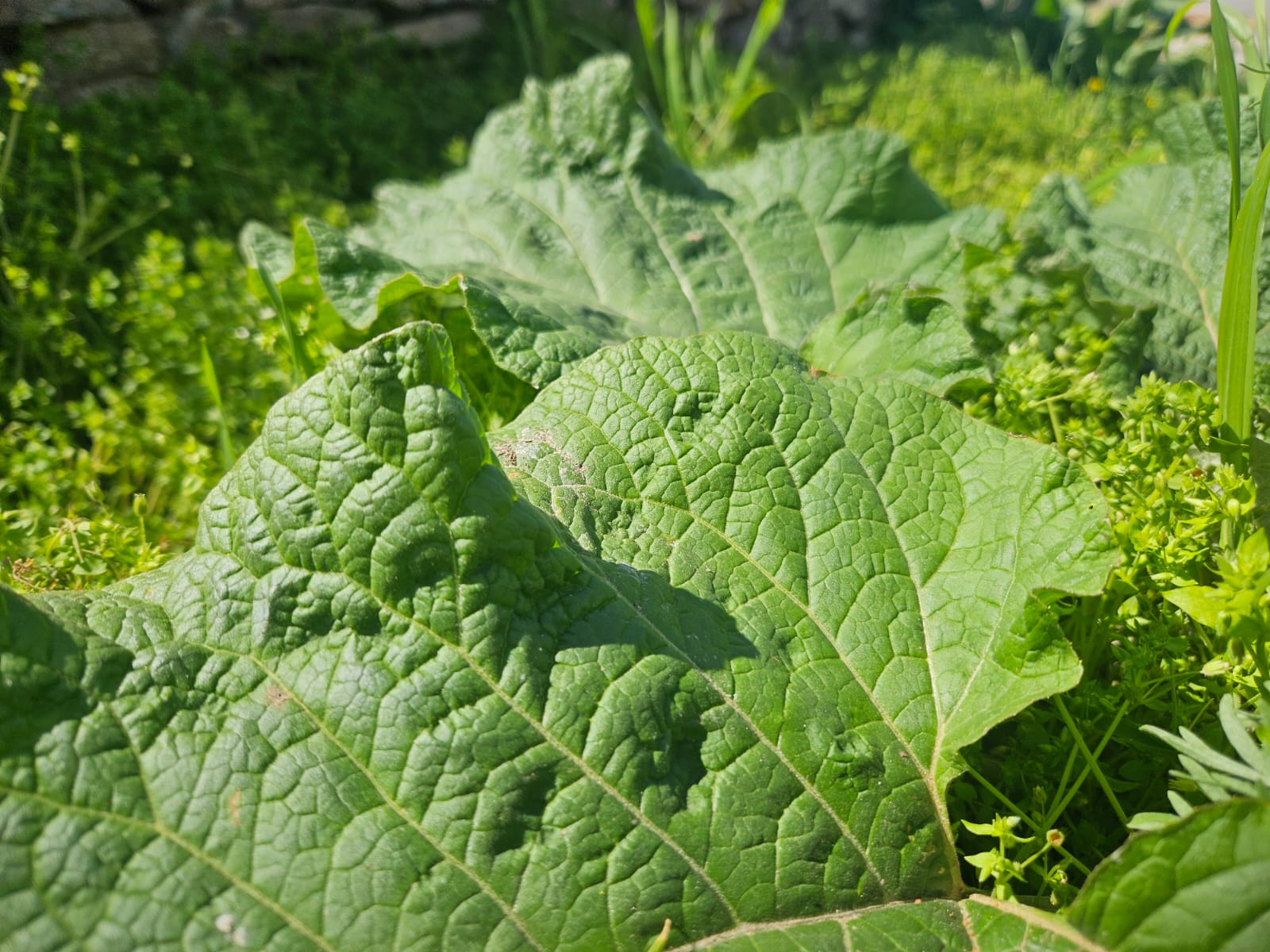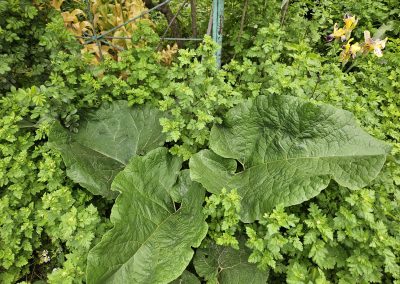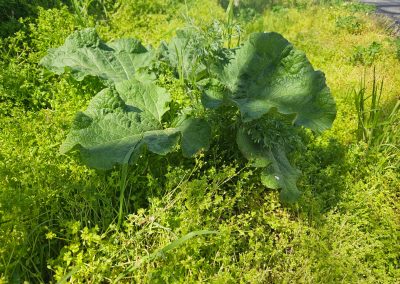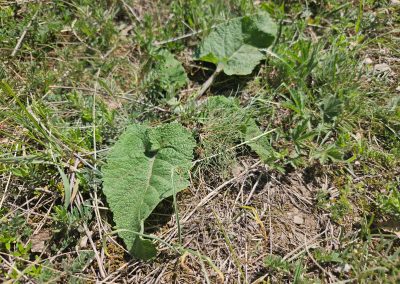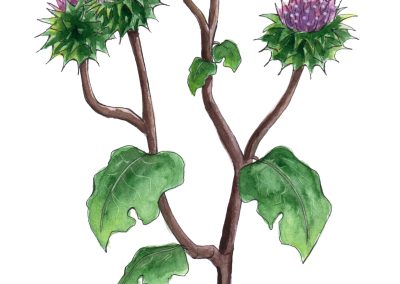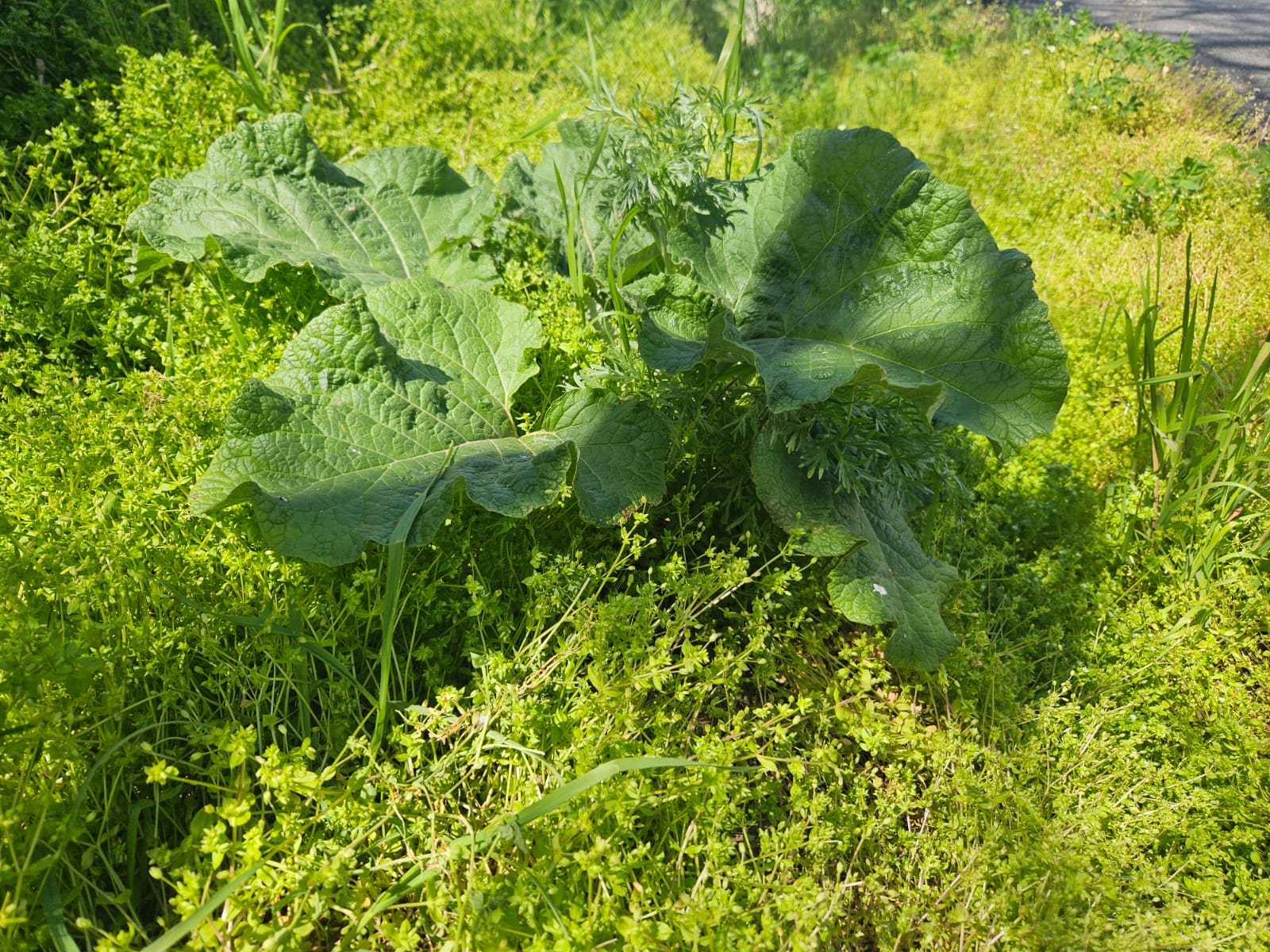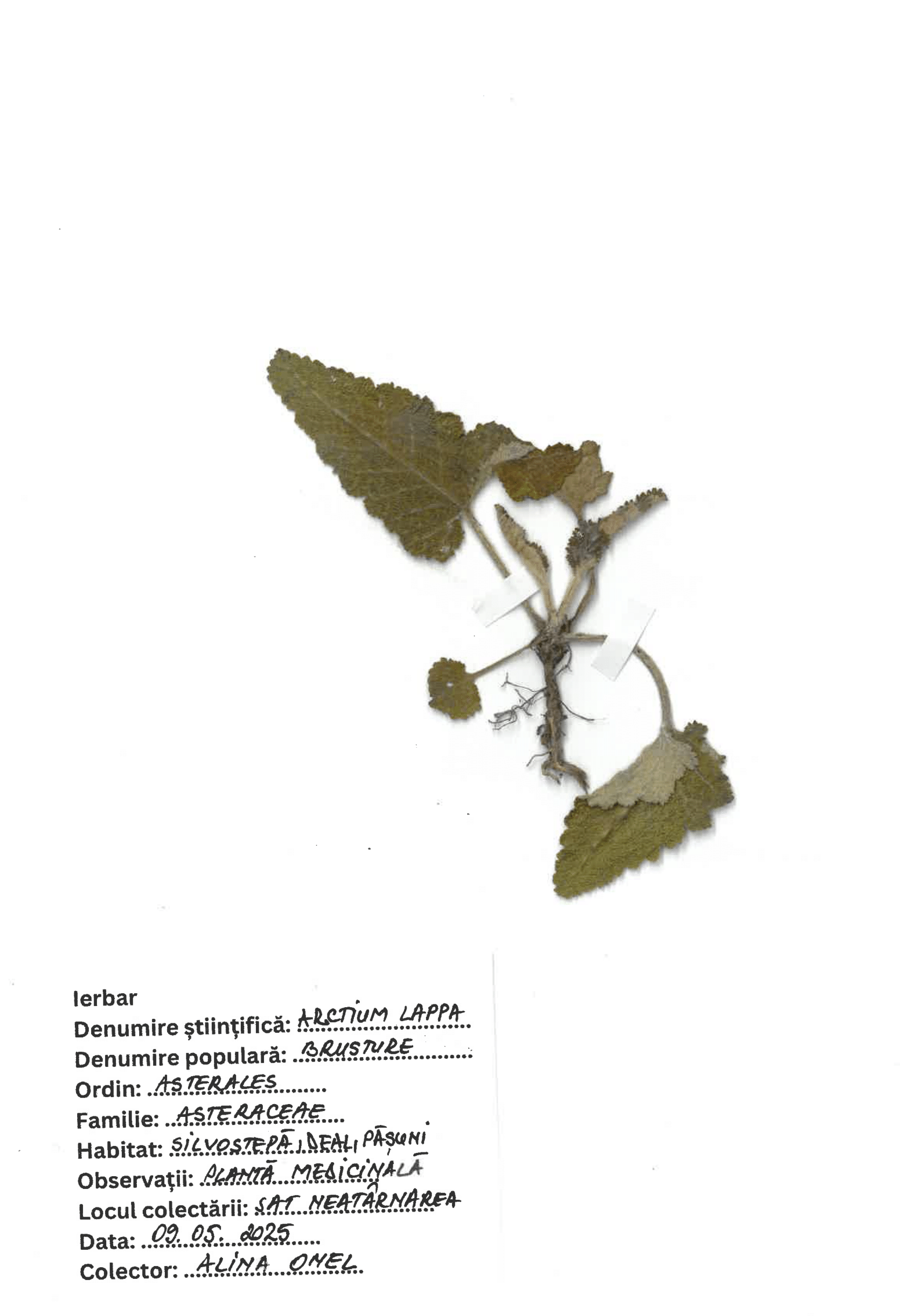Arctium Lappa
Scientific description
Taxon: Angiospermatophyta (Magnoliophyta)
Class: Dycotyledonatae (Magnoliatae)
Subclass: Asteridae
Order: Asterales
Family: Asteraceae
Subfamily: Asteroideae (Tubuliflorae)
Origin: The species is native to temperate regions.
Description:
It is a biennial herbaceous species, growing up to 2 meters in height. The root is taprooted. The leaves in the first year are very large, arranged in a rosette, long-petiolated, with a soft, broad, heart-shaped triangular lamina, with a mucronate apex. The upper side of the leaves is glabrous, while the underside is tomentose. In the second year, strong flowering stems develop, with large rosette leaves at the base and smaller leaves along the stem. The inflorescences are capitula, purple or violet in color, arranged in a corymb. The capitula are globular, 3–4 cm in diameter, with numerous spiny involucral bracts shaped like hooks, which allow them to cling to the fur of animals and be carried over long distances. It blooms in mid-summer. The fruits are achenes, 6 mm long, compressed.
Propagation:
By seed, as soon as the fruits reach physiological maturity.
Ecology:
In our country, it is a common species, growing on uncultivated land, in bushes, forest edges, wastelands, and along roadsides, from the plains to the mountainous regions. It prefers sunny spots with moderate humidity, is resistant to drought and frost.
Uses:
It is a plant with pharmaceutical uses. The roots of the burdock are harvested, containing inulin, essential oils, potassium salts, and B vitamins, and are used for various conditions: as a depurative, capillary tonic, disinfectant, and blood purifier, even helping with the elimination of renal toxins. In Japanese cuisine, it is cultivated for human consumption; the stems have the taste of artichoke, and the roots are crunchy with a sweet flavor.
Încrengătura: Angiospermatophyta (Magnoliophyta)
Clasa: Dycotyledonatae (Magnoliatae)
Subclasa: Asteridae
Ordinul: Asterales
Familia: Asteraceae
Subfamilia: Asteroideae (Tubuliflorae)
Origine: specia este nativă regiunilor temperate.
Descrierea:
este o specie ierboasă bianuală, până la 2 metri înălțime. Rădăcina pivotantă. Frunzele din primul an foarte mari dispuse în rozetă, sunt lung pețiolate, au limbul moale, lat triunghiular cordat, mucronat la vârf, pe față sunt glabre, iar pe dos tometoase. În anul al doilea se dezvoltă tulpinile florifere puternice, care au la bază frunze mari dispuse în rozetă, iar pe tulpina mai mici. Inflorescențele sunt calatidii, de culoare purpurie, mov-violet dispuse în corimb. Calatidiile sunt globuloase, au 3–4 cm diametru, cu numeroase foliole involucrale țepoase, sub forma unui cârlig, permițând să se agațe de blana animalelor și să fie cărate pe distanțe mari. Înflorește la mijlocul verii. Fructele sunt achene, cu o lungime de 6 mm, comprimate.
Înmulțirea:
prin sămânță imediat ce fructele au ajuns la maturitatea fiziologică.
Ecologia:
la noi în țară crește este o specie comună, se dezvoltă pe terenuri necultivate, tufișuri, margine de pădure, locuri virane, marginea drumului, de la câmpie până la regiunea montană. Preferă locurile însorite, cu umiditate moderată, rezistă la secetă și ger.
Utilizare:
este o plantă cu întrebuințare farmaceutică. De la brusture se recoltează rădăcinile care conțin inulină, ulei volatil, săruri de potasiu, vitamine din grupa B pentru diferite afecțiuni: depurativ, tonic capilar, dezinfectant și purificator al sângelui, ajutând chiar la eliminarea toxinelor renale. În bucătăria japoneză este cultivat pentru alimentația umană, tulpinile având gustul anghinarei, iar rădăcinile sunt crocante cu arome dulci.
Γένος: Angiospermatophyta (Magnoliophyta)
Τάξη: (Magnoliatae)
Υποκατηγορία: Asteridae
Τάξη: Asterales
Οικογένεια: Asteraceae
Υποοικογένεια: Asteroideae (Tubuliflorae)
Καταγωγή: Το είδος είναι ενδημικό σε εύκρατες περιοχές.
Περιγραφή:
είναι διετές βότανο, ύψους έως 2 μέτρα. Ρίζα. Τα φύλλα κατά τον πρώτο χρόνο είναι πολύ μεγάλα και σε σχήμα ροζέτας, μακρόστενα, με μαλακό, πλατύ τριγωνικό καρδιόσχημο φύλλο, βλεννώδες στην άκρη, άτριχο στο μπροστινό μέρος και μυώδες στο πίσω μέρος. Το δεύτερο έτος αναπτύσσονται ισχυρά ανθοφόρα στελέχη, με μεγάλα φύλλα σε σχήμα ροζέτας στη βάση και μικρότερα στο στέλεχος. Οι ταξιανθίες είναι καλαθοειδείς, πορφυρές, πορφυρού-πορφυρού χρώματος, διατεταγμένες σε στεφάνη. Τα καλαθίδια είναι σφαιρικά, διαμέτρου 3–4 cm, με πολυάριθμα αγκαθωτά εμφυλλώματα, σε σχήμα γάντζου, που τους επιτρέπουν να προσκολλώνται στο τρίχωμα των ζώων και να μεταφέρονται σε μεγάλες αποστάσεις. Ανθίζει στα μέσα του καλοκαιριού. Οι καρποί είναι αχαίνια, μήκους 6 mm, συμπιεσμένα.
Πολλαπλασιασμός:
με σπόρο μόλις οι καρποί φθάσουν σε φυσιολογική ωριμότητα.
Οικολογία:
στη χώρα μας είναι κοινό είδος, φύεται σε ακαλλιέργητες εκτάσεις, θάμνους, παρυφές δασών, ακαλλιέργητους χώρους, άκρες δρόμων, από τις πεδιάδες μέχρι τα βουνά. Προτιμά ηλιόλουστες, μέτρια υγρές, ανθεκτικές στην ξηρασία και τον παγετό θέσεις.
Χρήση:
είναι φυτό με φαρμακευτική χρήση. Οι ρίζες συλλέγονται από τον κολλιτσίδα και περιέχουν ινουλίνη, πτητικό έλαιο, άλατα καλίου, βιταμίνες Β για διάφορες παθήσεις: απολυμαντικό, τονωτικό των τριχοειδών αγγείων, απολυμαντικό και καθαριστικό του αίματος, βοηθώντας ακόμη και στην αποβολή των τοξινών των νεφρών. Στην ιαπωνική κουζίνα καλλιεργείται για ανθρώπινη κατανάλωση, οι μίσχοι έχουν γεύση αγκινάρας και οι ρίζες είναι τραγανές με γλυκές γεύσεις.
Taxonomie : Angiospermatophyta (Magnoliophyta)
Classe : Dycotylédonées (Magnoliatae)
Sous-classe : Asteridae
Ordre : Asterales
Famille : Asteraceae
Sous-famille : Asteroideae (Tubuliflorae)
Origine : L'espèce est originaire des régions tempérées.
Description :
C'est une espèce herbacée bisannuelle, pouvant atteindre 2 mètres de hauteur. La racine est pivotante. La première année, les feuilles sont très grandes, disposées en rosette, longuement pétiolées, avec un limbe triangulaire doux, large, en forme de cœur, avec un apex mucroné. La face supérieure des feuilles est glabre, tandis que la face inférieure est tomenteuse. Au cours de la deuxième année, de fortes tiges fleuries se développent, avec de grandes feuilles en rosette à la base et des feuilles plus petites le long de la tige. Les inflorescences sont des capitules de couleur pourpre ou violette, disposés en corymbe. Les capitules sont globuleux, de 3–4 cm de diamètre, avec de nombreuses bractées involucrales épineuses en forme de crochets, ce qui leur permet de s'accrocher au pelage des animaux et d'être transportés sur de longues distances. Elle fleurit au milieu de l'été. Les fruits sont des akènes de 6 mm de long, comprimés.
Propagation :
Par semences, dès que les fruits atteignent leur maturité physiologique.
Écologie :
Dans notre pays, il s'agit d'une espèce commune, qui pousse sur les terres non cultivées, dans les buissons, les lisières de forêts, les friches et le long des routes, des plaines aux régions montagneuses. Elle préfère les endroits ensoleillés avec une humidité modérée, elle est résistante à la sécheresse et au gel.
Utilisations :
C'est une plante à usage pharmaceutique. On récolte les racines de la bardane qui contiennent de l'inuline, des huiles essentielles, des sels de potassium et des vitamines B. Elles sont utilisées pour diverses affections : comme dépuratif, tonique capillaire, désinfectant et purificateur sanguin, aidant même à l'élimination des toxines rénales. Dans la cuisine japonaise, il est cultivé pour la consommation humaine ; les tiges ont le goût de l'artichaut et les racines sont croquantes et ont une saveur douce.
Creative writing inspired by Arctium Lappa
The Outcast’s Ally
Long ago, in a kingdom that prized beauty above all, there lived a young girl named Maelen. She was not like the other girls—her hair was tangled with leaves, her hands stained with soil, and her voice always hummed to the rhythm of the wild. She wandered the woods more than the markets, and for that, the townspeople called her “bramble-born” and turned their backs.
Banished to the edge of the forest, Maelen made her home among the roots and rivers. Her only comfort came from a strange, stubborn plant with broad leaves and hooked burrs that clung to her skirts like they never wanted to let go. She called it burdock, and it seemed to grow where nothing else dared to.
One cruel winter, a terrible sickness fell upon the kingdom. The nobles withered, and the golden healers’ tonics failed. Desperate, the king called out to the woods for help—but none dared go near… except for Maelen.
She returned, cloaked in moss and wind, carrying bundles of rough burdock root. The people sneered—until her bitter brew revived the dying, one by one. Even the king, half gone to fever, was brought back with her potion.
Humbled and awed, the court demanded to know the name of the strange, healing root. She smiled and answered:
“The outcast’s ally. The stubborn friend. Burdock.”
The king, ashamed, offered her riches and a place in the palace. But Maelen declined, choosing the wild where her roots ran deep. From then on, burdock was called the King of the Weeds, a symbol of resilience and hidden power—ugly to some, but vital to those who knew its worth.
To this day, they say if a burdock burr clings to you, it’s not a nuisance—it’s a sign that something wild and wise has chosen to walk with you.


